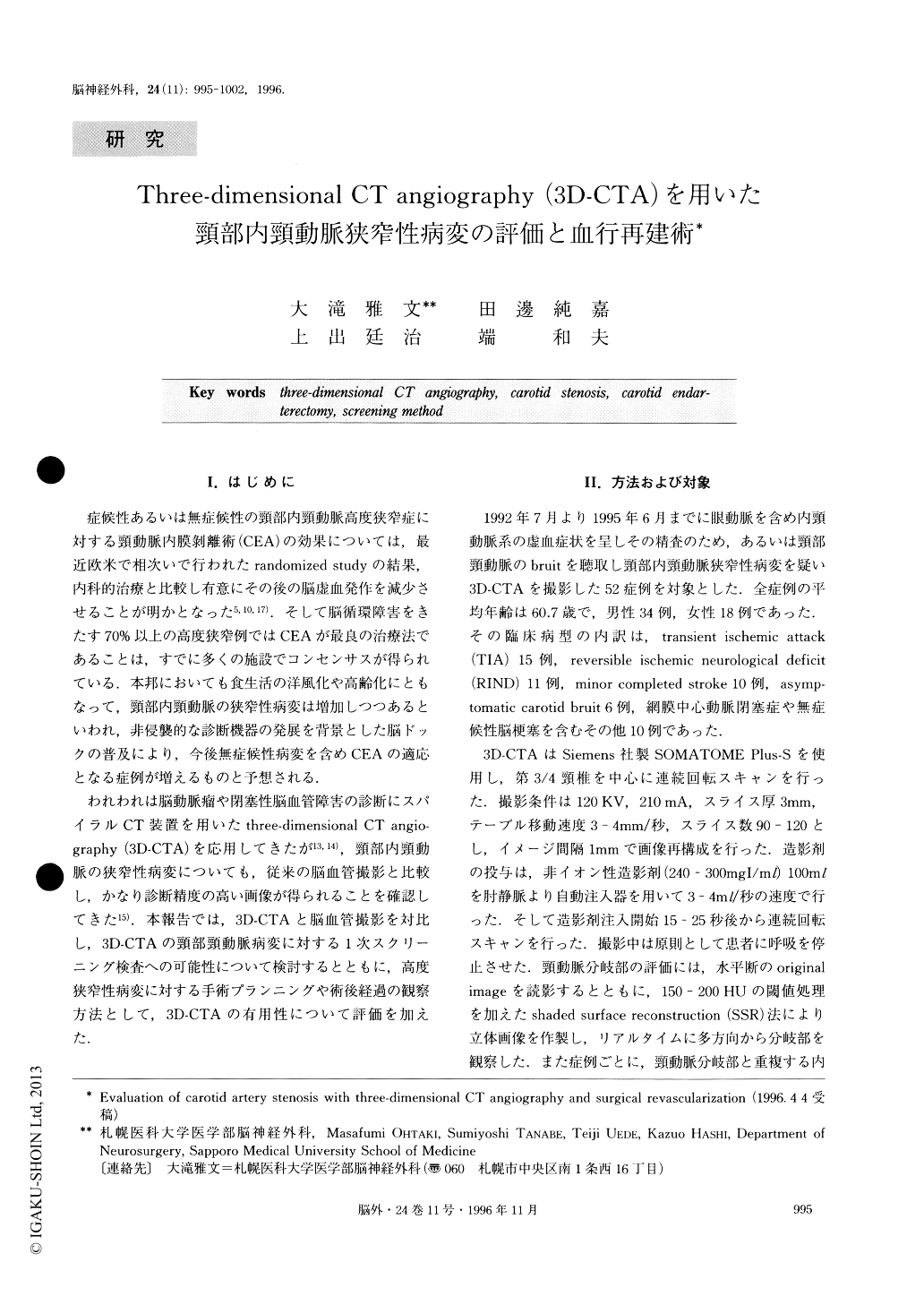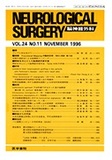Japanese
English
- 有料閲覧
- Abstract 文献概要
- 1ページ目 Look Inside
I.はじめに
症候性あるいは無症候性の頸部内頸動脈高度狭窄症に対する頸動脈内膜剥離術(CEA)の効果については,最近欧米で相次いで行われたrandomized studyの結果,内科的治療と比較し有意にその後の脳虚血発作を減少させることが明かとなった5,10,17).そして脳循環障害をきたす70%以上の高度狭窄例ではCEAが最良の治療法であることは,すでに多くの施設でコンセンサスが得られている.本邦においても食生活の洋風化や高齢化にともなって,頸部内頸動脈の狭窄性病変は増加しつつあるといわれ,非侵襲的な診断機器の発展を背景とした脳ドックの普及により,今後無症候性病変を含めCEAの適応となる症例が増えるものと予想される.
われわれは脳動脈瘤や閉塞性脳血管障害の診断にスパイラルCT装置を用いたthree-dimensional CT angio—graphy(3D-CTA)を応用してきたが13,14),頸部内頸動脈の狭窄性病変についても,従来の脳血管撮影と比較し,かなり診断精度の高い画像が得られることを確認してきた15).本報告では,3D-CTAと脳血管撮影を対比し,3D-CTAの頸部頸動脈病変に対する1次スクリーニング検査への可能性について検討するとともに,高度狭窄性病変に対する手術プランニングや術後経過の観察方法として,3D-CTAの有用性について評価を加えた.
The accuracy of three-dimensional CT angiography (3D-CTA) for delineating atherosclerotic carotid steno-sis was examined in comparison with digital subtrac-tion angiography (DSA) in symptomatic patients. In cases undergoing carotid endarterectomy (CEA), the clinical usefulness of 3D-CTA for surgical planning was also evaluated in the light of intraoperative findings.
From July 1992 to Jun 1995, 52 patients suffering from internal carotid ischemia and/or presenting caro-tid bruit were evaluated to detect carotid bifurcation stenosis by 3D-CTA. Shaded surface reconstruction (SSR) for three-dimensional display and maximum in-tensity projection (MIP) were employed in multiple projection to evaluate sites of stenosis. DSA was per-formed in 18 out of 31 patients having atherosclerotic carotid stenosis shown by 3D-CTA.
MIP reconstructions accurately delineated sites of stenosis close to DSA and allowed precise depiction of ulcerated plaque and intramural calcification. The per-centage of carotid stenosis was determined by compar-ing the narrowest point to the internal carotid artery (ICA) beyond the bulb on both 3D-CTA and DSA. Assessment of carotid stenosis was highly correlated between 3D-CTA and DSA (r=0.987, p<0.0001). In this series, 9 carotid arteries in 8 patients underwent CEA for severe stenosis. 3 patients with ICA occlusion and 1 patient with elongated severe stenosis underwent STA-MCA anastomosis. Using MIP reconstructions and two-dimensional original images it was found that ICA occlusion was apparently distinguished from high grade ICA stenosis. SSR provided valuable informa-tions during CEA for atherosclerotic plaque regarding anatomical relationship with the internal jugular vein and bony structures.
This advanced means of 3D-CTA can be adequate as a screening method to detect carotid stenosis in symp-tomatic patients and useful for surgical planning of CEA and post-operative follow-up examination.

Copyright © 1996, Igaku-Shoin Ltd. All rights reserved.


